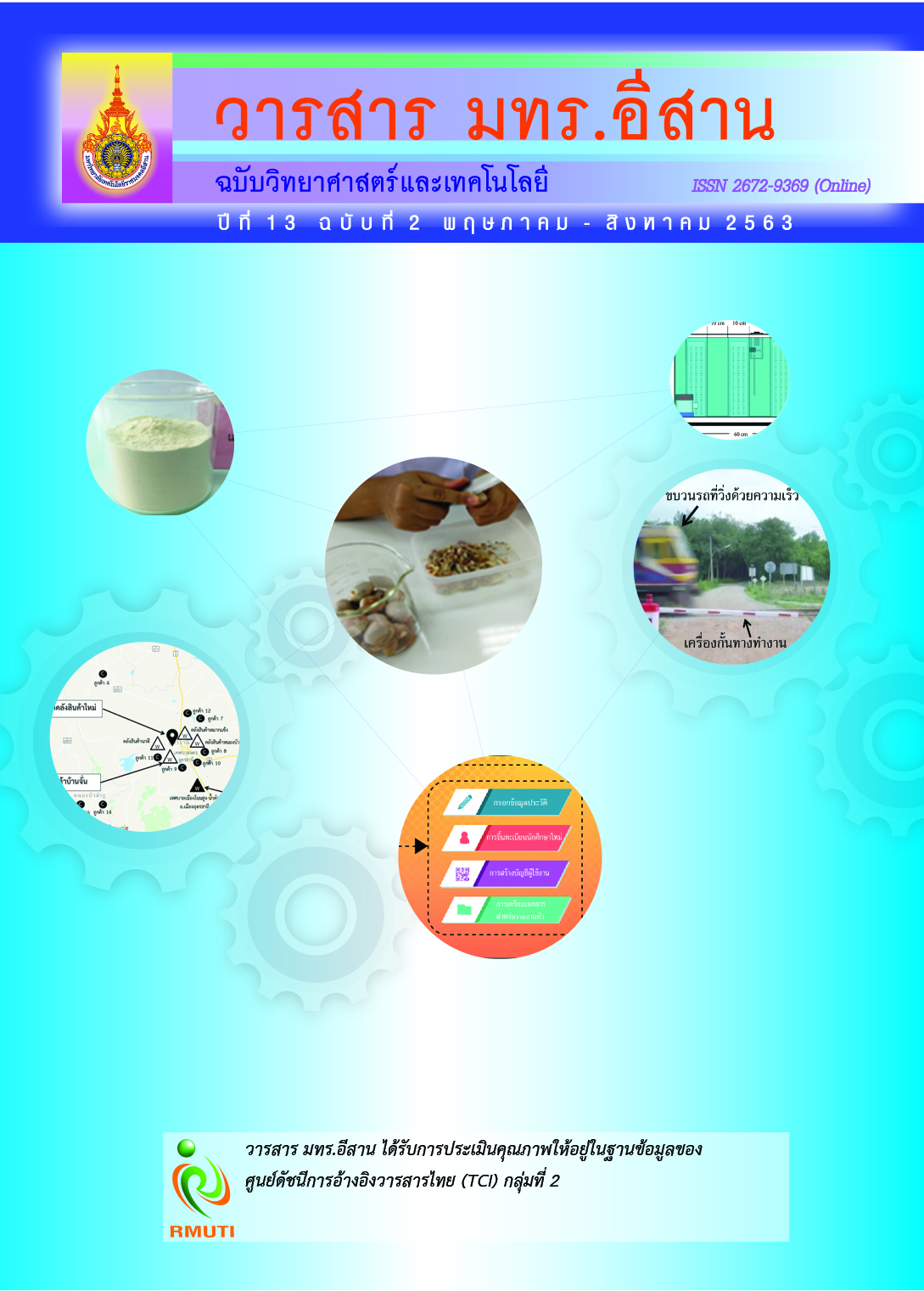Warehouse Location Selection Using Analytic Hierarchy Process for Special Controlled Warehouse
Main Article Content
Abstract
The objective of this research is to select the appropriate specially controlled warehouse location in Udon Thani Province related with the examining of the center of gravity coordinates with the hierarchical analysis process. From the outcome, it cannot be determined the location of the warehouse because the coordinates are government areas, which are guilty under the Alcoholic Beverage Control Act, Article 27 (3). Therefore, it must identify the local area to that coordinate. It is found that there are 4 locations that can be set up at Ban Chan Warehouse, Nadi warehouse, Mak Khaeng warehouse, and Nong Bua warehouse. The major factors in location selection through the analysis hierarchical process are cost, infrastructure, society and environment. The secondary factors are the warehouse costs, freight costs, labor costs, tax costs, access to the main roads, information systems, utilities community impact on youth air pollution and noise pollution. From the analysis, it was found that the social and environmental have the highest mean weight of 0.5136. The secondary impact factor from the community has the highest weight mean value is 0.2180. Therefore, the Ban Chan warehouse is an appropriate location with the highest mean weight of importance of 0.3122.
Article Details
References
The Secretariat of the Cabinet. (2008). Alcohol Beverage Control Act. Thailand: Cabinet and Royal Gazette Publishing Office
Plan for System Development Model and Method of Treatment for People with Integrated Alcohol Consumption Problems. (2010). Caring for Employees in the Workplace to Prevent and Solve Alcohol Drinking Problems. Thailand: Plan for System Development Model and Method of Treatment for People with Integrated Alcohol Consumption Problems
Krungsri Research. (2019). Beverage Industry. Access (11 July 2019). Available (www.krungsri.com/bank/getmedia/77793dc9-0214-4a51-9dd1-d16af17ebcd/IO_Beverage_190503_
TH_EX.aspx)
Institute for Population and Social Research Mahidol University and Office of Health Promotion Fund and National Bureau of Health Commission. (2010). Thai Health 2010 Social Capital Crisis Opportunity. Thailand: Amarin Printing and Publishing Public Company Limited
Chachoengsao Justice Provincial Office Ministry of Justic. (2013). Campaign to Enforce Laws to Prohibit the Sale of Alcohol and Cigarettes to Children Under 18. Access (12 July 2019). Available (http://chachoengsao.moj.go.th/article_details.php?id=18&fbclid=IwAR2ORDQ_KKLdXhbVR6BAW-O4pJGSC1z9ecXodEfBtFwBqld F86t4xH-zG3E)
Center for Alcohol Studies. (2007). Control of Alcohol Problems by Law. Thailand: Soda Studio Creation and Publishing
Ghadge, A., Yang, Q., and Caldwell, N. (2016). Facility Location for a Closed-Loop Distribution Network a Hybrid Approach. International Journal of Retail & Distribution Management. Vol. 44, Issue 9, pp. 884-902. DOI: 10.1108/IJRDM-07-2015-0094
Guo, F. and Shi, X. (2018). Research on the Logistics Node Location of Beijing Xinfadi Branch Center. In IMMS ‘18: Proceedings of the 2018 International Conference on Information Management & Management Science. pp. 105-108. DOI: 10.1145/3277139.3277159
Wimonket, R. and Opasanon, S. (2008). Finding a Suitable Location for the Container Loading Center Between the Hulls in the Eastern Region. Thai VCML Journal. Vol. 1, No. 1, pp. 99-110
Gutierrez, M. T. E. and Mutuc, J. E. S. (2018). A Model for Humanitarian Supply Chain An Operation Research Approach. Procedia Engineering. Vol. 212, pp. 884-902. DOI: 10.1016/j.proeng.2018.01.085
Homchalee, R. (2015). A Study Appropriate Supply Chain Model for Ethanol Industry in Thailand. Ph.D. Industrial Engineering, Faculty of Engineering, Khon Kaen University
Sirisena, H. O. and Samarasekera, N. A. (2018). Vessel Spare Parts Distribution Center Location Decision Model for Ship Maintenance Supply Chain. In 2018 IEEE International Conference on Service Operations and Logistics, and Informatics (SOLI). pp. 185-190. DOI: 10.1109/SOLI.2018.8476802
Juan, J. S., Fernandez, C., Lim, B., Lim, E., and Li, R. (2017). A Tool for Selecting Optimal Emergency Response Unit Locations Using an Integrated AHP-MILP Approach. In 2017 IEEE International Conference on Industrial Engineering and Engineering Management (IEEM). pp. 185-190. DOI: 10.1109/IEEM.2017.8289843
Rahimi, F., Goli, A., and Rezaee, R. (2017). Hospital Location-Allocation in Shiraz Using Geographical Information System (GIS). Shiraz E-Medical Journal. Vol. 18, No. 8, pp. 1-8. DOI: 10.5812/semj.57572
Tezcan, S., Ocak, S., and Top, M. (2019). Analytic Hierarchy Process for Hospital Site Selection. Health Policy and Technology. Vol. 8, Issue 1, pp. 42-50. DOI: 10.1016/j.hlpt.2019.02.005
He, Y., Wang, X., Lin, Y., Zhou, F., and Zhou, L. (2017). Sustainable Decision Making for Joint Distribution Center Location Choice. Transportation Research Part D: Transport and Environment. Vol. 55, pp. 202-216. DOI: 10.1016/J.TRD.2017.07.001
Eursiriwan, N., Panichgarn, V., Rangsan, D., and Warichwattana, U. (2017). The Selection Criteria of Suitable Location for Weigh Station Establishment Using the Analytical Hierarchy Process (AHP). Kasem Bundit Engineering Journal. Vol. 7, No. 1, pp. 17-33
Wang, X. (2017). Research on the Location of the Hazardous Chemical Distribution Center Under the Supply Chain Environment. Chemical Engineering Transactions. Vol. 62, pp. 1351-1356. DOI: 10.3303/CET1762226
Pluemudom, A. and Smakgahn, K. (2017). Appropriate Sanitation Assessment of Landfill Pond Construction Case Study in Mueang Samut Prakan District, Samut Prakan Province. Veridian E-Journal, Science and Technology Silpakorn University. Vol. 4, Number 5, pp. 93-103
Ding, Z., Zhu, M., Wu, Z., Yanbin Fu, Y., and Liu, X. (2018). Combining AHP-Entropy Approach with GIS for Construction Waste Landfill Selection-A Case Study of Shenzhen. International Journal of Environmental Research and Public Health. Vol. 15, Issue 10, pp. 1-21. DOI: 10.3390/ijerph15102254
Randazzo, L., Cusumano, A., Oliveri, G., Stefano, P. D., Renda, P., Perricone, M., and Zarcone, G. (2018). Landfill Site Select for Municipal Solid Waste by Using AHP Method in GIS Environment Waste Management Decision Support in Sicily (Italy). Multidisciplinary Journal for Waste Resources & Residues. Vol. 2, pp. 78-88. DOI: 10.31025/2611-4135/2018.13656
Kabak, M. and Keskin, I. (2018). Hazardous Materials Warehouse Selection Based on GIS and MCDM. Arabian Journal for Science and Engineering. Vol. 43, No. 6, pp. 3269-3278. DOI: 10.1007/s13369-018-3063-z
Akgün, İ. and Erdal, H. (2019). Solving an Ammunition Distribution Network Design Problem Using Multi-Objective Mathematical Modeling, Combined AHP-TOPSIS, and GIS. Computers & Industrial Engineering. Vol. 129, pp. 512-528. DOI: 10.1016/j.cie.2019.02.004


